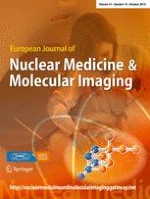Published in:

01-10-2014 | Original Article
177 Lu-Dota-octreotate radionuclide therapy of advanced gastrointestinal neuroendocrine tumors: results from a phase II study
Authors:
Giovanni Paganelli, Maddalena Sansovini, Alice Ambrosetti, Stefano Severi, Manuela Monti, Emanuela Scarpi, Caterina Donati, Annarita Ianniello, Federica Matteucci, Dino Amadori
Published in:
European Journal of Nuclear Medicine and Molecular Imaging
|
Issue 10/2014
Login to get access
Abstract
Purpose
We evaluated the activity and safety profile of 177Lu-Dotatate peptide receptor radionuclide therapy (Lu-PRRT) in patients with advanced, well-differentiated (G1-G2) gastrointestinal neuroendocrine tumors (GI-NETs).
Methods
Forty-three patients with radiological tumor progression at baseline and a positive Octreoscan® completed the treatment with Lu-PRRT, resulting in the cumulative activity of 18.5 or 27.8 GBq in five cycles. Total activity was scheduled on the basis of kidney function or bone marrow reserve.
Results
Twenty-five (58 %) patients were treated with a “standard” Lu-PRRT full dosage (FD) of 25.7 GBq (range 22.2-27.8), while the remaining 18 patients (42 %) who, at enrolment, showed a higher probability of developing kidney or bone marrow toxicity received a reduced dosage (RD) of 18.4 GBq (range 14.4-20.4). According to SWOG criteria, the overall response was complete response (CR) in (7 %) cases and stable disease (SD) in 33 (77 %), with a disease control rate (DCR) of 84 %. Median response duration was 25 months (range 7-50). Median progression-free survival (PFS) was 36 months (95 % CI 24-nr), and median overall survival (OS) has not yet been reached. Remarkably, none of the patients, including those at a higher risk of toxicity, showed side-effects after either dosage of Lu-PRRT.
Conclusion
Lu-PRRT was shown to be an effective therapeutic option in our patients with advanced progressive GI-NETs, showing an 84 % DCR (95 % CI 73-95) that lasted for 25 months and a PFS of 36 months. Both activities of 27.8 GBq and 18.5 GBq proved safe and effective in all patients, including those with a higher probability of developing kidney or bone marrow toxicity.





